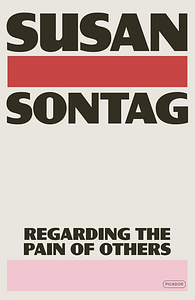Take a photo of a barcode or cover
challenging
dark
informative
reflective
sad
tense
medium-paced
Interesting meditation on the photography and images from war. Sontag's critical faculties were sharp right up to the end.
emotional
informative
inspiring
fast-paced
challenging
dark
informative
reflective
sad
slow-paced
still so relevant, 20 years after being published. war and history is cyclical & people are still figuring out ways to compartmentalize the atrocities. Sontag’s predictions about the future of news and online information are spot on.
Graphic: Body horror, Genocide, Gore, Gun violence, Violence, Grief, Murder, Colonisation, War, Injury/Injury detail
dark
informative
reflective
sad
tense
medium-paced
thought provoking, but suffers from some redundancy and lack of photographic examples
informative
reflective
‘Regarding The Pain of Others’ is a book about viewing the tragedies of war through a camera lens. Susan Sontag cites many war photographers and dissects their photographs, the context behind them, and what they represent. One of the main questions discussed is that in an age of an unrestricted and extravagant flow of war images, what culminative effect does it have on the viewer? One the one hand, there is garnering of sympathy and awareness necessary to initiate action. On the other hand, there is the desensitisation to violence, and -a particularly hard-to-swallow idea -the creation or satisfaction of voyeuristic appetites. She speaks of prominent war photographs from the Bosnian War, the Holocaust, lynchings of African Americans and 9/11. A particular poignant point was how the ubiquity of uncensored photographs of terrorised bodies from certain colonised parts of the world has fed the notion of war being inherent to such areas -and has led to the desensitisation to their pain. Meanwhile, fallen American soldiers have often enjoyed the dignity of anonymity.
Another interesting point was the comparison of photographs with videos -a photograph is a freeze-frame of a single moment, and is more likely to be impactful and retained in our memory. However, A photograph is but a mere token of a more severe reality. And the viewer is nothing but that -no matter how much pity and compassion the image incites in them. She speaks of how images have been reproached for being a lazy, unfeeling, privileged way of watching suffering from a distance, but ultimately argues that it is impossible for such images to make the viewer ‘suffer enough’ like those in it -they simply boil down to being ‘an invitation to pay attention’.
‘The image says: This is what human beings are capable of doing -may volunteer to do, enthusiastically, self-righteously. Don’t forget.’
Another interesting point was the comparison of photographs with videos -a photograph is a freeze-frame of a single moment, and is more likely to be impactful and retained in our memory. However, A photograph is but a mere token of a more severe reality. And the viewer is nothing but that -no matter how much pity and compassion the image incites in them. She speaks of how images have been reproached for being a lazy, unfeeling, privileged way of watching suffering from a distance, but ultimately argues that it is impossible for such images to make the viewer ‘suffer enough’ like those in it -they simply boil down to being ‘an invitation to pay attention’.
‘The image says: This is what human beings are capable of doing -may volunteer to do, enthusiastically, self-righteously. Don’t forget.’





